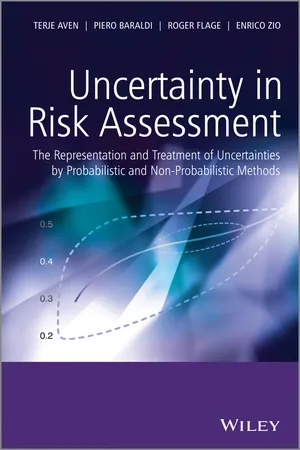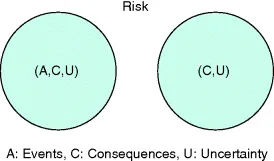![]()
Part I
Introduction
![]()
1
Introduction
Risk assessment is a methodological framework for determining the nature and extent of the risk associated with an activity. It comprises the following three main steps:
- Identification of relevant sources of risk (threats, hazards, opportunities)
- Cause and consequence analysis, including assessments of exposures and vulnerabilities
- Risk description.
Risk assessment is now widely used in the context of various types of activities as a tool to support decision making in the selection of appropriate protective and mitigating arrangements and measures, as well as in ensuring compliance with requirements set by, for example, regulatory agencies. The basis of risk assessment is the systematic use of analytical methods whose quantification is largely probability based. Common methods used to systematically analyze the causes and consequences of failure configurations and accident scenarios are fault trees and event trees, Markov models, and Bayesian belief networks; statistical methods are used to process the numerical data and make inferences. These modeling methods have been developed to gain knowledge about cause–effect relationships, express the strength of these relationships, characterize the remaining uncertainties, and describe, in quantitative or qualitative form, other properties relevant for risk management (IAEA, 1995; IEC, 1993). In short, risk assessments specify what is at stake, assess the uncertainties of relevant quantities, and produce a risk description which provides information useful for the decision-making process of risk management.
In this book we put the main focus on quantitative risk assessment (QRA), where risk is expressed using an adequate representation of the uncertainties involved. To further develop the methodological framework of risk assessment, we will need to explain in more detail what we mean by risk.
This introductory chapter is organized as follows. Following Section 1.1, which addresses the risk concept, we present in Section 1.2 the main features of probabilistic risk assessment (PRA), which is a QRA based on the use of probability to characterize and represent the uncertainties. Then, in Section 1.3, we discuss the use of risk assessment in decision-making contexts. Section 1.4 considers the issue of uncertainties in risk assessment, motivated by the thesis that if uncertainty cannot be properly treated in risk assessment, the risk assessment tool fails to perform as intended (Aven and Zio, 2011). This section is followed by a discussion on the main challenges of the probability-based approaches to risk assessment, and the associated uncertainty analysis. Alternative approaches for dealing with uncertainty are briefly discussed.
1.1 Risk
1.1.1 The Concept of Risk
In all generality, risk arises wherever there exists a potential source of damage or loss, that is, a hazard (threat), to a target, for example, people, industrial assets, or the environment. Under these conditions, safeguards are typically devised to prevent the occurrence of the hazardous conditions, and protection is put in place to counter and mitigate the associated undesired consequences. The presence of a hazard does not in itself suffice to define a condition of risk; indeed, inherent in the latter there is the uncertainty that the hazard translates from potential to actual damage, bypassing safeguards and protection. In synthesis, the notion of risk involves some kind of loss or damage that might be received by a target and the uncertainty of its transformation in actual loss or damage, see Figure 1.1. Schematically we can write (Kaplan and Garrick, 1981; Zio, 2007; Aven, 2012b)
Normally, the consequence dimension relates to some type of undesirable outcome (damage, loss, harm). Note that by centering the risk definition around undesirable outcomes, we need to define what is undesirable, and for whom. An outcome could be positive for some stakeholders and negative for others: discussing whether an outcome is classified in the right category may not be worth the effort, and most of the general definitions of risk today allow for both positive and negative outcomes (Aven and Renn, 2009).
Let A denote a hazard/threat, C the associated consequences, and U the uncertainties (will A occur, and what will C be?). The consequences relate to something that humans value (health, the environment, assets, etc.). Using these symbols we can write (1.1) as
or simply
where C in (C, U) expresses all consequences of the given activity, including the hazardous/threatful events A. These two risk representations are shown in Figure 1.2.
Obviously, the concept of risk cannot be limited to one particular measuring device (e.g., probability) if we seek a general risk concept. For the measure introduced, we have to explain precisely what it actually expresses. We also have to clarify the limitations with respect to its ability to measure the uncertainties: is there a need for a supplement to fully describe the risk? We will thoroughly discuss these issues throughout the book.
A concept closely related to risk is vulnerability (given the occurrence of an event A). Conceptually vulnerability is the same as risk, but conditional on the occurrence of an event A:
where the symbol | indicates “given” or “conditional.” For short we write
1.1.2 Describing/Measuring Risk
The risk concept has been defined above. However, this concept does not give us a tool for assessing and managing risk. For this purpose we must have a way of describing or measuring risk, and the issue is how.
As we have seen, risk has two main dimensions, consequences and uncertainty, and a risk description is obtained by specifying the consequences
and using a description (measure) of the uncertainty,
. The most common tool is probability
, but others exist and these also will be given due attention in the book. Specifying the consequences means identifying a set of quantities of interest
that represent the consequences
, for example, the number of fatalities.
Now, depending on the principles laid down for specifying
and the choice of
, we obtain different perspectives on how to describe/measure risk. As a general description of risk we can write
where
is the background knowledge (models and data used, assumptions made, etc.) that
and the specification
are based on, see
Figure 1.3. On the basis of the relation between vulnerability and risk previously introduced, the vulnerability given an event
is analogously described by
.
1.1.3 Examples
1.1.3.1 Offshore Oil and Gas Installation
Consider the future operation of an offshore installation for oil and gas processing. We all agree that there is some “risk” associated with this operation. For example, fires and explosions could occur leading to fatalities, oil spills, economic losses, and so on. Today we do not know if these events will occur and what the specific consequences will be: we are faced with uncertainties and, thus, risk. Risk is two dimensional, comprising events and consequences, and associated uncertainties (i.e., the events and consequences being unknown, the occurrences of the events are not known and the consequence...





















